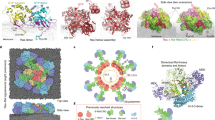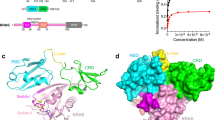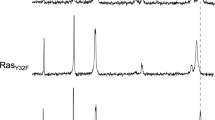Abstract
The kinetics of Ras activation by Son of sevenless (SOS) changes profoundly when Ras is tethered to membranes, instead of being in solution. SOS has two binding sites for Ras, one of which is an allosteric site that is distal to the active site. The activity of the SOS catalytic unit (SOScat) is up to 500-fold higher when Ras is on membranes compared to rates in solution, because the allosteric Ras site anchors SOScat to the membrane. This effect is blocked by the N-terminal segment of SOS, which occludes the allosteric site. We show that SOS responds to the membrane density of Ras molecules, to their state of GTP loading and to the membrane concentration of phosphatidylinositol-4,5-bisphosphate (PIP2), and that the integration of these signals potentiates the release of autoinhibition.
This is a preview of subscription content, access via your institution
Access options
Subscribe to this journal
Receive 12 print issues and online access
$189.00 per year
only $15.75 per issue
Buy this article
- Purchase on Springer Link
- Instant access to full article PDF
Prices may be subject to local taxes which are calculated during checkout









Similar content being viewed by others
Change history
15 May 2008
In the version of this article initially published, the concentration units reported in Figure 7b,c should be nM, not nm. The green data series in Figure 7b should be labeled “SOScat”. In addition, on page 452 of the article, the affiliation address for William J. Galush and Jay T. Groves was incorrect. Their correct address is Department of Chemistry, University of California, Berkeley, California 94720, USA. Finally, the last sentence of the Acknowledgments listed incorrect funding information. The last sentence should read, “J.T.G. and W.J.G. are supported by Chemical Sciences, Geosciences and Biosciences Division, Office of Basic Energy Sciences of the US Department of Energy under Contract No. DE_AC03-76SF00098, and D.B.-S. by NIH GM078266.” These errors have been corrected in the HTML and PDF versions of the article.
References
Pawson, T. & Scott, J.D. Signaling through scaffold, anchoring, and adaptor proteins. Science 278, 2075–2080 (1997).
Kholodenko, B.N., Hoek, J.B. & Westerhoff, H.V. Why cytoplasmic signalling proteins should be recruited to cell membranes. Trends Cell Biol. 10, 173–178 (2000).
Kuriyan, J. & Eisenberg, D. The origin of protein interactions and allostery in colocalization. Nature 450, 983–990 (2007).
Schlessinger, J. Cell signaling by receptor tyrosine kinases. Cell 103, 211–225 (2000).
Quilliam, L.A. New insights into the mechanisms of SOS activation. Sci. STKE 2007, pe67 (2007).
Boriack-Sjodin, P.A., Margarit, S.M., Bar-Sagi, D. & Kuriyan, J. The structural basis of the activation of Ras by Sos. Nature 394, 337–343 (1998).
Aronheim, A. et al. Membrane targeting of the nucleotide exchange factor Sos is sufficient for activating the Ras signaling pathway. Cell 78, 949–961 (1994).
Margarit, S.M. et al. Structural evidence for feedback activation by Ras·GTP of the Ras-specific nucleotide exchange factor SOS. Cell 112, 685–695 (2003).
Freedman, T.S. et al. A Ras-induced conformational switch in the Ras activator Son of sevenless. Proc. Natl. Acad. Sci. USA 103, 16692–16697 (2006).
Sondermann, H. et al. Structural analysis of autoinhibition in the Ras activator Son of sevenless. Cell 119, 393–405 (2004).
Boykevisch, S. et al. Regulation of Ras signaling dynamics by Sos-mediated positive feedback. Curr. Biol. 16, 2173–2179 (2006).
Roose, J.P., Mollenauer, M., Ho, M., Kurosaki, T. & Weiss, A. Unusual interplay of two types of Ras activators, RasGRP and SOS, establishes sensitive and robust Ras activation in lymphocytes. Mol. Cell. Biol. 27, 2732–2745 (2007).
Soisson, S.M., Nimnual, A.S., Uy, M., Bar-Sagi, D. & Kuriyan, J. Crystal structure of the Dbl and pleckstrin homology domains from the human Son of sevenless protein. Cell 95, 259–268 (1998).
Zheng, J. et al. The solution structure of the pleckstrin homology domain of human SOS1. A possible structural role for the sequential association of diffuse B cell lymphoma and pleckstrin homology domains. J. Biol. Chem. 272, 30340–30344 (1997).
Kubiseski, T.J., Chook, Y.M., Parris, W.E., Rozakis-Adcock, M. & Pawson, T. High affinity binding of the pleckstrin homology domain of mSos1 to phosphatidylinositol (4,5)-bisphosphate. J. Biol. Chem. 272, 1799–1804 (1997).
Koshiba, S. et al. The solution structure of the pleckstrin homology domain of mouse Son-of-sevenless 1 (mSos1). J. Mol. Biol. 269, 579–591 (1997).
Chen, R.H., Corbalan-Garcia, S. & Bar-Sagi, D. The role of the PH domain in the signal-dependent membrane targeting of Sos. EMBO J. 16, 1351–1359 (1997).
Zhao, C., Du, G., Skowronek, K., Frohman, M.A. & Bar-Sagi, D. Phospholipase D2-generated phosphatidic acid couples EGFR stimulation to Ras activation by Sos. Nat. Cell Biol. 9, 707–712 (2007).
Buday, L. & Downward, J. Epidermal growth factor regulates p21ras through the formation of a complex of receptor, Grb2 adapter protein, and Sos nucleotide exchange factor. Cell 73, 611–620 (1993).
Egan, S.E. et al. Association of Sos Ras exchange protein with Grb2 is implicated in tyrosine kinase signal transduction and transformation. Nature 363, 45–51 (1993).
Gale, N.W., Kaplan, S., Lowenstein, E.J., Schlessinger, J. & Bar-Sagi, D. Grb2 mediates the EGF-dependent activation of guanine nucleotide exchange on Ras. Nature 363, 88–92 (1993).
Li, N. et al. Guanine-nucleotide-releasing factor hSos1 binds to Grb2 and links receptor tyrosine kinases to Ras signalling. Nature 363, 85–88 (1993).
Sondermann, H., Soisson, S.M., Bar-Sagi, D. & Kuriyan, J. Tandem histone folds in the structure of the N-terminal segment of the ras activator Son of Sevenless. Structure 11, 1583–1593 (2003).
Sondermann, H., Nagar, B., Bar-Sagi, D. & Kuriyan, J. Computational docking and solution X-ray scattering predict a membrane-interacting role for the histone domain of the Ras activator Son of sevenless. Proc. Natl. Acad. Sci. USA 102, 16632–16637 (2005).
Tartaglia, M. & Gelb, B.D. Noonan syndrome and related disorders: genetics and pathogenesis. Annu. Rev. Genomics Hum. Genet. 6, 45–68 (2005).
Roberts, A.E. et al. Germline gain-of-function mutations in SOS1 cause Noonan syndrome. Nat. Genet. 39, 70–74 (2007).
Tartaglia, M. et al. Gain-of-function SOS1 mutations cause a distinctive form of Noonan syndrome. Nat. Genet. 39, 75–79 (2007).
McNew, J.A. et al. Close is not enough: SNARE-dependent membrane fusion requires an active mechanism that transduces force to membrane anchors. J. Cell Biol. 150, 105–117 (2000).
Pechlivanis, M., Ringel, R., Popkirova, B. & Kuhlmann, J. Prenylation of Ras facilitates hSOS1-promoted nucleotide exchange, upon Ras binding to the regulatory site. Biochemistry 46, 5341–5348 (2007).
Lenzen, C., Cool, R.H. & Wittinghofer, A. Analysis of intrinsic and CDC25-stimulated guanine nucleotide exchange of p21ras-nucleotide complexes by fluorescence measurements. Methods Enzymol. 255, 95–109 (1995).
Guo, Z., Ahmadian, M.R. & Goody, R.S. Guanine nucleotide exchange factors operate by a simple allosteric competitive mechanism. Biochemistry 44, 15423–15429 (2005).
Ahmadian, M.R., Wittinghofer, A. & Herrmann, C. Fluorescence methods in the study of small GTP-binding proteins. Methods Mol. Biol. 189, 45–63 (2002).
Groves, J.T. & Dustin, M.L. Supported planar bilayers in studies on immune cell adhesion and communication. J. Immunol. Methods 278, 19–32 (2003).
Scheele, J.S., Rhee, J.M. & Boss, G.R. Determination of absolute amounts of GDP and GTP bound to Ras in mammalian cells: comparison of parental and Ras-overproducing NIH 3T3 fibroblasts. Proc. Natl. Acad. Sci. USA 92, 1097–1100 (1995).
Tian, T. et al. Plasma membrane nanoswitches generate high-fidelity Ras signal transduction. Nat. Cell Biol. 9, 905–914 (2007).
Plowman, S.J., Muncke, C., Parton, R.G. & Hancock, J.F. H-ras, K-ras, and inner plasma membrane raft proteins operate in nanoclusters with differential dependence on the actin cytoskeleton. Proc. Natl. Acad. Sci. USA 102, 15500–15505 (2005).
Lenzen, C., Cool, R.H., Prinz, H., Kuhlmann, J. & Wittinghofer, A. Kinetic analysis by fluorescence of the interaction between Ras and the catalytic domain of the guanine nucleotide exchange factor Cdc25Mm. Biochemistry 37, 7420–7430 (1998).
Mor, A. et al. The lymphocyte function-associated antigen-1 receptor costimulates plasma membrane Ras via phospholipase D2. Nat. Cell Biol. 9, 713–719 (2007).
McLaughlin, S., Wang, J., Gambhir, A. & Murray, D. PIP(2) and proteins: interactions, organization, and information flow. Annu. Rev. Biophys. Biomol. Struct. 31, 151–175 (2002).
Honda, A. et al. Phosphatidylinositol 4-phosphate 5-kinase α is a downstream effector of the small G protein ARF6 in membrane ruffle formation. Cell 99, 521–532 (1999).
Papayannopoulos, V. et al. A polybasic motif allows N-WASP to act as a sensor of PIP(2) density. Mol. Cell 17, 181–191 (2005).
Buck, M., Xu, W. & Rosen, M.K. A two-state allosteric model for autoinhibition rationalizes WASP signal integration and targeting. J. Mol. Biol. 338, 271–285 (2004).
Acknowledgements
We thank T. Freedman, O. Kuchment, N. Endres, X. Zhang and M. Lamers for helpful discussions; and D. King for MS. J.G. is supported by the Molecular Biophysics US National Institutes of Health (NIH) grant T32 GM008295. J.T.G. and W.J.G. are supported by Chemical Sciences, Geosciences and Biosciences Division, Office of Basic Energy Sciences of the US Department of Energy under Contract No. DE_AC03-76SF00098, and D.B.-S. by NIH GM078266.
Author information
Authors and Affiliations
Corresponding authors
Supplementary information
Supplementary Text and Figures
Supplementary Figures 1–5, Supplementary Table 1, Supplementary Methods and Supplementary Discussion (PDF 492 kb)
Rights and permissions
About this article
Cite this article
Gureasko, J., Galush, W., Boykevisch, S. et al. Membrane-dependent signal integration by the Ras activator Son of sevenless. Nat Struct Mol Biol 15, 452–461 (2008). https://doi.org/10.1038/nsmb.1418
Received:
Accepted:
Published:
Issue Date:
DOI: https://doi.org/10.1038/nsmb.1418
This article is cited by
-
Repurposing Niclosamide as a plausible neurotherapeutic in autism spectrum disorders, targeting mitochondrial dysfunction: a strong hypothesis
Metabolic Brain Disease (2023)
-
A small and highly sensitive red/far-red optogenetic switch for applications in mammals
Nature Biotechnology (2022)
-
Phase separation in immune signalling
Nature Reviews Immunology (2022)
-
A structural model of a Ras–Raf signalosome
Nature Structural & Molecular Biology (2021)
-
Hericium erinaceus potentially rescues behavioural motor deficits through ERK-CREB-PSD95 neuroprotective mechanisms in rat model of 3-acetylpyridine-induced cerebellar ataxia
Scientific Reports (2020)



